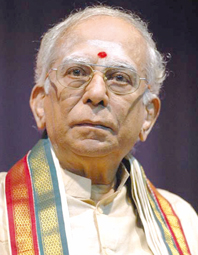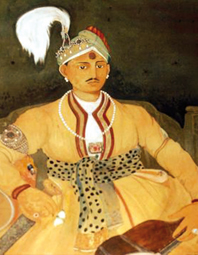COVER STORY - Lalgudi G. Jayaraman by T.T. NARENDRAN

The world of Carnatic music has plunged into grief over the loss of Lalgudi G. Jayaraman, an outstanding musician. Rasikas of the 1940s and 50s are likely to have seen a young violin accompanist, attired in the traditional tuft and kadukkans or ear-studs, responding to the briga speed of GNB and to the complex kanakku calculations of the Alathur brothers with alacrity. With his ability to match the wares of every musician he accompanied, he must have given a new definition to the role of violin accompaniment. He was acknowledged in the music world as one endowed with karpoora buddhi – intellectual reflexes akin to the instant combustibility of camphor.
The way he wielded the bow often made him sound close to the human voice. I recall a morning concert of Madurai Srirangam Iyengar at the Music Academy, in which, for a folk song at the end of the concert, he filled a gap, sounding identical to the human voice, by cleverly shifting to the lower octave. The impact was tremendous and drew spontaneous appreciation from the audience.
There was one occasion when a scholarly musician opened an alapana ostensibly in Suddha Bangala. In a soft tone, Lalgudi played the logical follow-up phrase rggrs in a manner that would fit only that raga and none of its allies. Ironically, the vocalist went into Nayaki thereafter, but Jayaraman, in that narrow interval, showed his class to the discerning members of the audience.
SPECIAL FEATURE - BICENTENARY OF SWATI TIRUNAL

The Swati Tirunal Compositions: Facts & Figures in a Whodunit was the title of a comprehensive article by K.V. Ramanathan on the controversy (courtesy veena maestro S. Balachander) over Swati Tirunal’s classical music compositions that appeared in Sruti 142. The article, while conceding that the authorship of some of the compositions attributed to Swati Tirunal might have belonged elsewhere, disagreed strongly with Balachander’s contention “that none of the compositions attributed to Swati Tirunal was created by him, that an elaborate conspiracy extending over several years had created what he called the Swati myth, and that, in fact, there never was such a person as Swati Tirunal.” The following article by Dr. Achuthsankar S. Nair lends further credence to K.V. Ramanathan’s argument that Swati Tirunal was indeed a composer.
Travancore’s composer king by DR. ACHUTHSANKAR S. NAIR
The bicentenary of Swati Tirunal or Padmanabha Dasa fell on 16 April 2013. The Swati star appeared, shining brightly but briefly towards the end of the era of the Trinity in Tanjavur, farther down south, beside the Karamana river in Tiruvananthapuram. Swati Tirunal was born on 16th April 1813 under the asterism ‘Swati’. In the Malayalam era the date is 988 ME, Medam (Mesham) 5 by Travancore tradition of astrology, and 988 Medam 6 by Malabar tradition. Omanatingal kidavo is a lullaby traditionally believed to have been composed for the young Swati or Ummini (as his mother called him) by the famous poet Ravi Varman Thampi (1783-1856 AD), also known as Irayimman Thampi.
NEWS & NOTES - Remembering Kittappa Pillai and Narmada by VEEJAY SAI
Every year Bengaluru’s cultural life is dotted with numerous dance and music festivals. Being a hub for dance gurus, the city has a number of institutions which continue to do yeoman service to the arts. The ‘Nirantara Narmada’ festival conducted by dancer Poornima Gururaja as a tribute to her guru the late vidushi Narmada, has grown to be a much awited event. This year was also special as it marked the centenary celebrations of the late natyacharya Tanjavur
K.P. Kittappa Pillai who groomed guru Narmada. It was a double-bonus for Poornima who celebrated the memory of her guru and her guru’s guru!
The event began with an elaborate talk on the life and times of Kittappa Pillai by senior musicologist and writer B.M. Sundaram. He elaborated on the history and cultural context in which Kittappa grew up, the legacy of the Tanjavur bani and the conditioning which nurtured Kittappa to become an able guru. His biographical details, some of which were revelations to many in the hall, elicited appreciative applause. Apart from Kittappa’s training under many gurus in dance, mridangam and music, BMS spoke fondly of a personal side of Kittappa that only a few close associates knew.
IN MEMORIAM - Music transcends religion

Eminent dhrupad exponent Ustad Zia Fariduddin Dagar passed away recently on 8 May. A member of the revered Dagar family of dhrupad musicians, he taught at the Dhrupad Kendra, Bhopal, along with his elder brother, Zia Mohiuddin Dagar for 25 years.
He spoke to Sruti correspondent SHUCHITA RAO last year. Excerpts from the conversation:
Tell us about your childhood and your introduction to dhrupad music.
I spent my childhood playing with friends and cousins. I was a very naughty child, quite a shaitaan! My father Ustad Ziauddin Khansahib, the court musician of Maharana Bhupal Singh of Udaipur, initiated me and my older brother Mohiuddin into learning dhrupads. He would make us sit together, tune the tambura carefully and ask us to sound the base kharaj note “Sa”. Then he would make us sing the basic scale sa re ga ma pa dha ni sa slowly for 30 minutes. He would ask us to think consciously while sounding out the notes. Then he would announce the lesson was over and ask us to go out and play.


